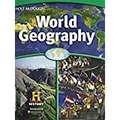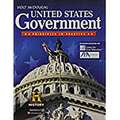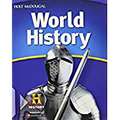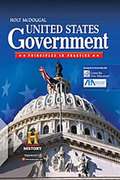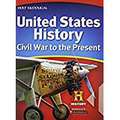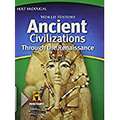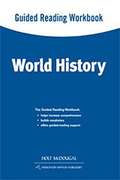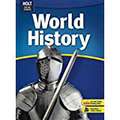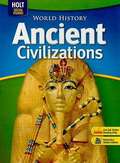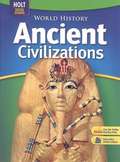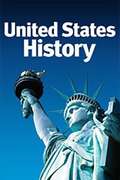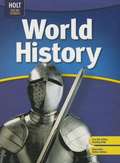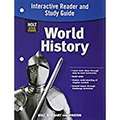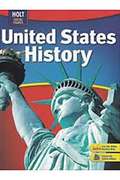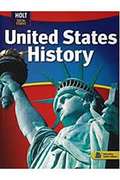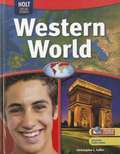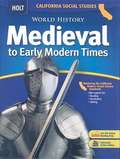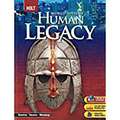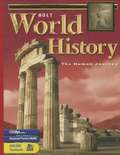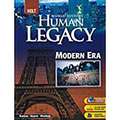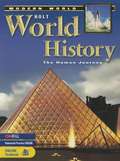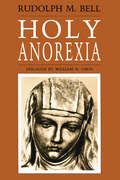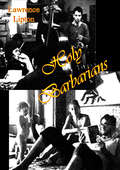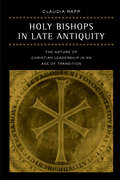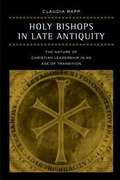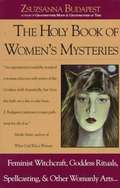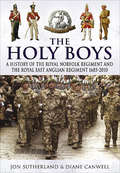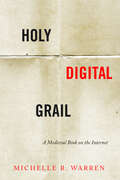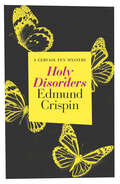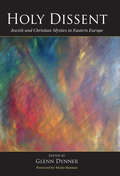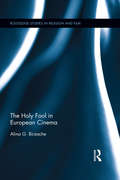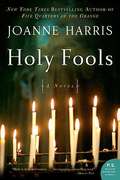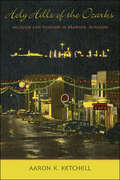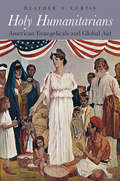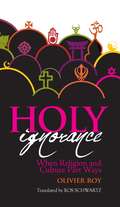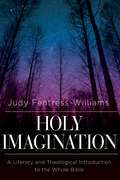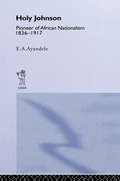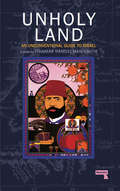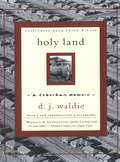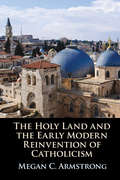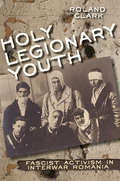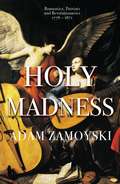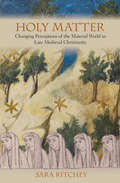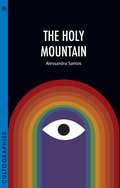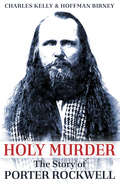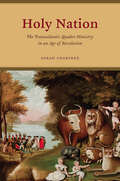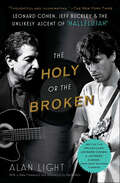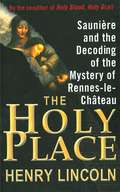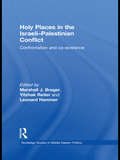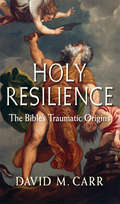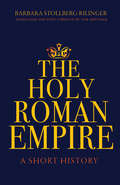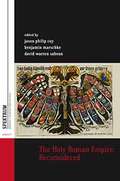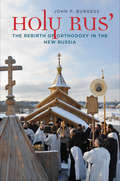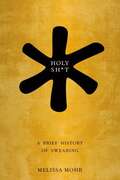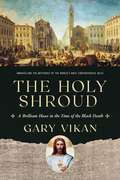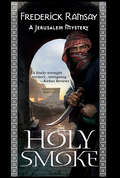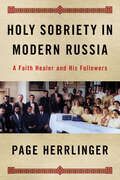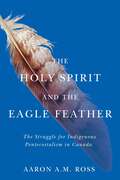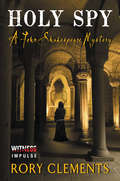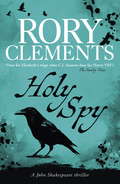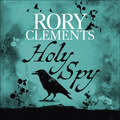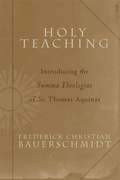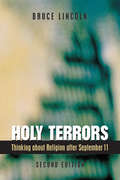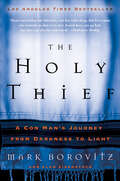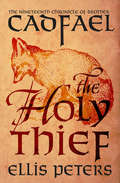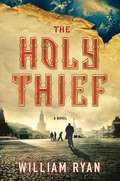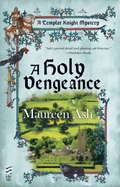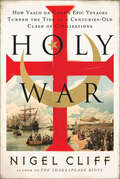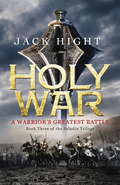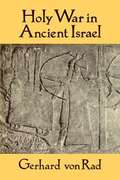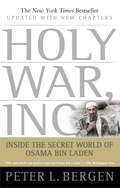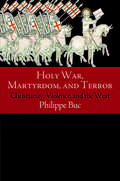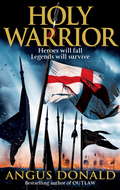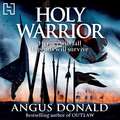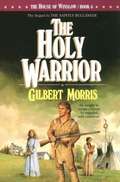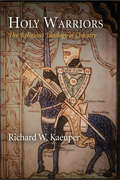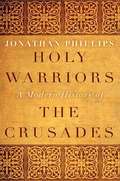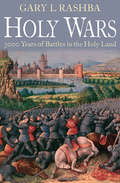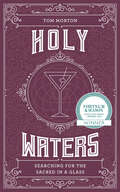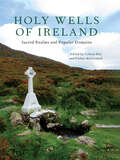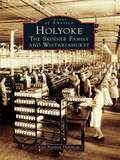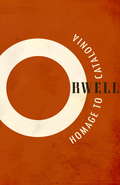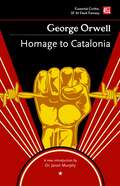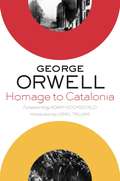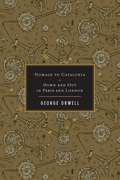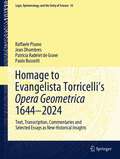- Table View
- List View
Holt McDougal Civics in Practice Florida Guided Reading Workbook
by Holt McdougalHolt McDougal Civics in Practice Florida: Guided Reading Workbook Integrated: Civics, Economics, and
Holt Mcdougal Government: Principles in Practice
by Holt McdougalThe U.S. Constitution outlines six fundamental principles that have guided American government for more than 200 years. The Framers of the Constitution established these six principles-popular sovereignty, limited government, separation of powers, checks and balances, judicial review, and federalism-as the basis of our national government.
Holt McDougal Middle School World History
by Stanley M. Burstein Richard ShekStudying history will be easy for you using this textbook.
Holt McDougal United States Government: Principles in Practice (Ohio Edition)
by Holt Mcdougal StaffThis book makes your study of U.S. government an enjoyable, meaningful experience. It helps you understand how our nation, through both its leaders and its people, has accepted the responsibilities of leadership-from the founding of the nation to the present day. By focusing your study of American government on these responsibilities, this book ensures students are able to accept the responsibilities required of all citizens and residents who are effectively engaged in American politics today.
Holt McDougal United States History: Civil War to the Present
by William Deverell Deborah Gray WhiteStudying U.S. history will be easy for you using this textbook.
Holt McDougal United States History: Beginnings to 1877, Guided Reading Workbook
by Holt McdougalThe Guided Reading Workbook helps increase comprehension, builds vocabulary, offers guided-reading support.
Holt McDougal World History: Ancient Civilizations Through the Renaissance
by Stanley M. Burstein Richard ShekLearn more about world history, from the earliest humans through the scholars and politicians of the European Renaissance.
Holt Mcdougal World History Guided Reading Workbook Grades 6-8 Survey
by Holt McdougalMiddle School History Workbook
Holt Social Studies: World History, Ancient Civilizations
by Stanley M. Burstein Richard ShekIn addition to the main text, this edition includes a 7-page Economics Handbook and a 54-page Reference Section.
Holt Social Studies: World History, Ancient Civilizations
by Stanley M. Burstein Richard ShekThe book equips one to be able to analyze historical materials, dig into history to create a richer understanding of the mysteries of the past.
Holt Social Studies: World History, Ancient Civilizations
by Stanley M. Burstein Richard ShekThis book will help students read, think and solve problems like historians.
Holt Social Studies: World History (Oklahoma Edition)
by Stanley M. Burstein Richard ShekFor students to understand history better World History Oklahoma Edition covers history in two different sources: primary and secondary.
Holt Social Studies: World History
by Stanley M. Burstein Richard ShekStudying world history will be easy for students using this textbook. With the easy-to-use structure and special features, this textbook will make history come alive for the students.
Holt Social Studies: United States History
by William Deverell Deborah Gray WhiteNIMAC-sourced textbook
Holt Social Studies: World History, Ancient Civilizations Interactive Reader and Study Guide
by Holt Rinehart WinstonHistory is the study of the past. Historians are people who study history. Historians want to know how people lived and why they did the things they did. They try to learn about the problems people faced and how they found solutions. They are interested in how people lived their daily lives. They study the past to understand people's culture.
Holt Social Studies World History, Interactive Reader and Study Guide
by Rinehart Winston HoltNIMAC-sourced textbook
Holt United States History
by William Deverell Deborah Gray WhiteStudents will learn history from different types of sources, mainly primary and secondary sources.
Holt United States History and New York State History
by William Deverell Deborah Gray WhiteThe 2009 Student Edition of the popular US History text.
Holt Western World
by Christopher L. SalterThis book is all about geography and history of the Western world along with test taking strategies.
Holt World History: Medieval to Early Modern Times (Calfornia Social Studies)
by Stanley M. Burstein Richard ShekHistory textbook for California students.
Holt World History: Human Legacy (Grades 9-12)
by Susan Elizabeth Ramirez Peter Stearns Sam Wineburg Steven A. GoldbergHolt World History: Human Legacy was created to make the study of world history an enjoyable, meaningful experience.
Holt World History
by Richard Shek Stanley BursteinThis textbook uses both primary and secondary sources to make students better historians.
Holt World History, The Human Journey
by Holt Rinehart WinstonAll you need to do is watch of read the news to see history unfolding. How many news stories do you see or hear about ordinary people doing extraordinary things? The Why It Matters Today feature beginning every section of the Human Journey invites you to use the vast resources of CNNfyi.com or other current event source to examine the links between past and present. Through this feature you will be able to draw connections between what you are studying in your history book and the events are taking place in out world today.
Holt World History, Human Legacy: Modern Era
by Susan Elizabeth Ramirez Peter Stearns Sam Wineburg Steven A. GoldbergNIMAC-sourced textbook
Holt World History, the Human Journey: Modern World
by Holt Rinehart WinstonHistory and geography share many elements. History describes important events that have taken place from ancient times until the present day. Geography describes how physical environments affect human events. It also examines how people's actions influence the environment around them. One way to look at geography is to identify essential elements of its study.
Holt World History, the Human Journey: Modern World
by Holt Rinehart WinstonThroughout The Human Journey, you are asked to think critically about the events and issues that have shaped world history. Critical thinking is the reasoned judgment of information and ideas. The development of critical thinking skills is essential to effective citizenship. Such skills empower you to exercise your civic rights and responsibilities. Helping you develop critical thinking skills is an important goal of The Human Journey. The following critical thinking skills appear in the section reviews and chapter reviews of the book.
Holt World History, the Human Journey: Ancient World
by Holt Rinehart WinstonHolt World History shows the relation between geography and history.
Holy Anorexia
by Rudolph M. BellIs there a resemblance between the contemporary anorexic teenager counting every calorie in her single-minded pursuit of thinness, and an ascetic medieval saint examining her every desire? Rudolph M. Bell suggests that the answer is yes. "Everyone interested in anorexia nervosa . . . should skim this book or study it. It will make you realize how dependent upon culture the definition of disease is. I will never look at an anorexic patient in the same way again."—Howard Spiro, M.D., Gastroenterology "[This] book is a first-class social history and is well-documented both in its historical and scientific portions."—Vern L. Bullough, American Historical Review "A significant contribution to revisionist history, which re-examines events in light of feminist thought. . . . Bell is particularly skillful in describing behavior within its time and culture, which would be bizarre by today's norms, without reducing it to the pathological."—Mary Lassance Parthun, Toronto Globe and Mail "Bell is both enlightened and convincing. His book is impressively researched, easy to read, and utterly fascinating."—Sheila MacLeod, New Statesman
Holy Barbarians
by Lawrence LiptonMr. Lipton's book is the first complete and unbiased survey of the beat generation and its role in our society. Here are the intimate facts about these people and their attitudes toward sex, dope, jazz, art, religion, parents, landlords, employers, politicians, draft boards, the law and, most important, toward the "square". The author presents a picture of their way of life, their individual backgrounds, the language they have appropriated, in terms made clear for the first time to those of us who have been confused and puzzled about them. He also provides a balanced discussion of their literature, art and music, of what they produce and fail to produce in the arts they practice.--Print Ed.
Holy Bishops in Late Antiquity: The Nature of Christian Leadership in an Age of Transition (Transformation of the Classical Heritage #37)
by Claudia RappBetween 300 and 600, Christianity experienced a momentous change from persecuted cult to state religion. One of the consequences of this shift was the evolution of the role of the bishop--as the highest Church official in his city--from model Christian to model citizen. Claudia Rapp's exceptionally learned, innovative, and groundbreaking work traces this transition with a twofold aim: to deemphasize the reign of the emperor Constantine, which has traditionally been regarded as a watershed in the development of the Church as an institution, and to bring to the fore the continued importance of the religious underpinnings of the bishop's role as civic leader. Rapp rejects Max Weber's categories of "charismatic" versus "institutional" authority that have traditionally been used to distinguish the nature of episcopal authority from that of the ascetic and holy man. Instead she proposes a model of spiritual authority, ascetic authority and pragmatic authority, in which a bishop's visible asceticism is taken as evidence of his spiritual powers and at the same time provides the justification for his public role. In clear and graceful prose, Rapp provides a wholly fresh analysis of the changing dynamics of social mobility as played out in episcopal appointments.
Holy Bishops in Late Antiquity: The Nature of Christian Leadership in an Age of Transition
by Claudia RappThis book offers a new interpretation of the nature of bishops' power in late antiquity, arguing that bishops had a pragmatic approach to power much like that of secular rulers.
The Holy Book of Women's Mysteries
by Zsuzsanna E. BudapestThe Holy Book of Women's Mysteries is essential for Pagans, feminists, and women seeking to learn more about the spiritual path as it relates to the feminine and the Goddess aspects of witchcraft and Wicca. This book is not about reinstating a matriarchy or tearing down patriarchy; it is about women's spirituality and its relationship with politics and lifestyle. Z. Budapest is one of the founding mothers of modern women's witchcraft, beginning with the establishment of Susan B. Anthony Coven in Los Angeles in 1971. She catapulted herself into the media spotlight when she was tried as a witch and found guilty in 1975 after being arrested on Venice Beach for reading tarot cards. She fought the charges and, after a nine year battle, won the right for every tarot reader to do so legally. The Holy Book of Women's Mysteries is a seminal text that contains invaluable information on Dianic witchcraft and spells, including everyday magick, sabbat rituals, and divination methods; a section on how vegetarian theories and politics relate to witchcraft and the feminine aspect; and a good deal of information on goddesses and how the patriarchal religions distorted old myths to serve their own needs. There are several unique and beautiful Rites of Passage for women and men that you don't often find, and Budapest's personal life stories are an equally valuable read, from her escape across the mountains from Communist Hungary to her fight for women's religious freedom upon moving to America.
The Holy Boys: A History of the Royal Norfolk Regiment and the Royal East Anglian Regiment 1685-2010
by Diane CanwellThe Royal Norfolk Regiment is one of the oldest and most distinguished fighting forces in the British army. Its line of descent can be traced back for over three centuries, all the way from modern Afghanistan to Monmouths rebellion in 1685.Throughout these years, and many campaigns, the regiment has maintained a marked local loyalty and tradition which remain strong today. This sense of local identity is celebrated by Jon Sutherland and Diane Canwell in this highly illustrated history of the regiment which describes, in graphic detail, the exploits of Norfolk soldiers who have made a notable contribution to the British army in every major conflict the country has faced.
Holy Digital Grail: A Medieval Book on the Internet (Stanford Text Technologies)
by Michelle R. WarrenMedieval books that survive today have been through a lot: singed by fire, mottled by mold, eaten by insects, annotated by readers, cut into fragments, or damaged through well-intentioned preservation efforts. In this book, Michelle Warren tells the story of one such manuscript—an Arthurian romance with textual origins in twelfth-century England now diffused across the twenty-first century internet. This trajectory has been propelled by a succession of technologies—from paper manufacture to printing to computers. Together, they have made literary history itself a cultural technology indebted to colonial capitalism. Bringing to bear media theory, medieval literary studies, and book history, Warren shows how digital infrastructures change texts and books, even very old ones. In the process, she uncovers a practice of "tech medievalism" that weaves through the history of computing since the mid-twentieth century; metaphors indebted to King Arthur and the Holy Grail are integral to some of the technologies that now sustain medieval books on the internet. This infrastructural approach to book history illuminates how the meaning of literature is made by many people besides canonical authors: translators, scribes, patrons, readers, collectors, librarians, cataloguers, editors, photographers, software programmers, and many more. Situated at the intersections of the digital humanities, library sciences, literary history, and book history, Holy Digital Grail offers new ways to conceptualize authorship, canon formation, and the definition of a "book."
Holy Disorders (The Gervase Fen Mysteries)
by Edmund CrispinThis 1945 classic British mystery from &“a master of the whodunnit . . . combines a flawless plot, witty dialogue and a touch of surreal hilarity&” (The New York Times Book Review). On holiday in the town of Tolnbridge with his butterfly net in hand, Prof. Gervase Fen, Oxford don of English Literature, is all set for a good frolic when he learns that the cathedral organist has been murdered. With Scotland Yard unable to make sense of the crime, Fen stands ready to step in. Whether he&’s chasing butterflies or catching criminals, it&’s all the same to this amateur sleuth with a penchant for literary allusions and an uncanny knack for solving the unsolvable: like why a small-town church musician would be mixed up with a local coven of witches—or a spy ring of Nazi sympathizers? Finding the answers provides endless amusement for Fen—and for readers as well—in this golden age English detective novel from Edmund Crispin, &“an absolute must for devotees of cultivated crime fiction.&” —Kirkus Reviews Praise for the mysteries of Edmund Crispin &“A marvellous comic sense.&” —P. D. James, New York Times–bestselling author of the Inspector Adam Dalgliesh series &“Master of fast-paced, tongue-in-cheek mystery novels, a blend of John Dickson Carr, Michael Innes, M.R. James, and the Marx Brothers.&” —Anthony Boucher, author of the Fergus O&’Breen series &“One of the most literate mystery writers of the twentieth century.&” —The Boston Globe &“Beneath a formidable exterior he had unsuspected depths of frivolity.&” —Philip Larkin, author of A Girl in Winter &“One of the last exponents of the classical English detective story.&” —The Times (London)
Holy Dissent: Jewish and Christian Mystics in Eastern Europe
by Glenn Dynner Moshe RosmanBrings together highly regarded scholars of Jewish and Christian mysticism in Eastern Europe to analyze the overlap of mysticism in the two religions.
The Holy Epistle to the Galatians
by D. Thomas Lancaster[Back Cover]: "Bible readers generally understand Galatians as Paul's dissertation against the Torah and against Judaism. More than any other book of the New Testament, Galatians defines the line between Messianic Judaism and greater Christianity.Paul was a prodigy educated in the most elite schools of Pharisaism. He wrote and thought from that Jewish background, rendering several key passages of his work incomprehensible to readers unfamiliar with rabbinic literature. This collection of sermons on a Messianic Jewish approach to Galatians opens Paul's world and provides the historical Jewish context necessary to decipher the epistle. In an easy-to-read, narrative style, Torah Club author D. Thomas Lancaster takes his readers from one end of the epistle to the other, challenging conventional interpretations and offering new insights to reveal the Jewish Paul."
The Holy Fool in European Cinema (Routledge Studies in Religion and Film)
by Alina G. BirzacheThis monograph explores the way that the profile and the critical functions of the holy fool have developed in European cinema, allowing this traditional figure to capture the imagination of new generations in an age of religious pluralism and secularization. Alina Birzache traces the cultural origins of the figure of the holy fool across a variety of European traditions. In so doing, she examines the critical functions of the holy fool as well as how filmmakers have used the figure to respond to and critique aspects of the modern world. Using a comparative approach, this study for the first time offers a comprehensive explanation of the enduring appeal of this protean and fascinating cinematic character. Birzache examines the trope of holy foolishness in Soviet and post-Soviet cinema, French cinema, and Danish cinema, corresponding broadly to and permitting analysis of the three main orientations in European Christianity: Orthodox, Catholic, and Protestant. This study will be of keen interest to scholars of religion and film, European cinema, and comparative religion.
Holy Fools
by Joanne HarrisJoanne Harris, bestselling author of Chocolat, presents her most accomplished novel yet -- an intoxicating concoction that blends theology and reason, deception and masquerade, with a dash of whimsical humor and a soupçon of sensuality. Britanny, 1610. Juliette, a one-time actress and rope dancer, is forced to seek refuge among the sisters of the abbey of Sainte Marie-de-la-mer. Reinventing herself as Soeur Auguste, Juliette makes a new life for herself and her young daughter, Fleur. But when the kindly abbess dies, Juliette's comfortable existence begins to unravel. The abbey's new leader is the daughter of a corrupt noble family, and she arrives with a ghost from Juliette's past -- Guy LeMerle, a man she has every reason to fear and hate. This P.S. edition features an extra 16 pages of insights into the book, including author interviews, recommended reading, and more.
Holy Hills of the Ozarks: Religion and Tourism in Branson, Missouri (Lived Religions)
by Aaron K. Ketchell“Confronts readers with the implications of a popular tourist destination founded on the values and sentiments of American evangelical Protestantism.” —Thomas S. Bremer, Journal of the American Academy of ReligionOver the past century, Branson, Missouri, has attracted tens of millions of tourists. Nestled in the heart of the Ozark Mountains, it offers a rare and refreshing combination of natural beauty and family-friendly recreation—from scenic lakes and rolling hills to theme parks and variety shows. It has boasted of big-name celebrities, like Wayne Newton, Andy Williams, and Petula Clark, as well as family entertainers like Mickey Gilley, the Shanghai Magic Troupe, Jim Stafford, and Yakov Smirnoff.But there is more to Branson’s fame than just recreation. As Aaron K. Ketchell discovers, a popular variant of Christianity underscores all Branson’s tourist attractions and fortifies every consumer success. In this lively and engaging study, Ketchell explores Branson’s unique blend of religion and recreation. He explains how the city became a mecca of conservative Christianity—a place for a “spiritual vacation”—and how, through conscious effort, its residents and businesses continuously reinforce its inextricable connection with the divine.Ketchell combines the study of lived religion, popular culture, evangelicalism, and contemporary American history to present an accurate and honest account of a distinctly American phenomenon.“As Ketchell brilliantly argues, Branson entrepreneurs wove Christian sentiment ‘into a fabric of nostalgia, premodern longing, and whitewashed rusticity.’” —Matthew Avery Sutton, The Christian Century“At a time when Jim Wallis and other observers have forecast the end of the prominence of right-wing-religion on the U.S. political stage, this book will cause many readers to question that prediction.” —David Stricklin, The Journal of Southern History
Holy Humanitarians: American Evangelicals and Global Aid
by Heather D. CurtisOn May 10, 1900, an enthusiastic Brooklyn crowd bid farewell to the Quito. The ship sailed for famine-stricken Bombay, carrying both tangible relief—thousands of tons of corn and seeds—and “a tender message of love and sympathy from God’s children on this side of the globe to those on the other.” The Quito may never have gotten under way without support from the era’s most influential religious newspaper, the Christian Herald, which urged its American readers to alleviate poverty and suffering abroad and at home. In Holy Humanitarians, Heather D. Curtis argues that evangelical media campaigns transformed how Americans responded to domestic crises and foreign disasters during a pivotal period for the nation. Through graphic reporting and the emerging medium of photography, evangelical publishers fostered a tremendously popular movement of faith-based aid that rivaled the achievements of competing agencies like the American Red Cross. By maintaining that the United States was divinely ordained to help the world’s oppressed and needy, the Christian Herald linked humanitarian assistance with American nationalism at a time when the country was stepping onto the global stage. Social reform, missionary activity, disaster relief, and economic and military expansion could all be understood as integral features of Christian charity. Drawing on rigorous archival research, Curtis lays bare the theological motivations, social forces, cultural assumptions, business calculations, and political dynamics that shaped America’s ambivalent embrace of evangelical philanthropy. In the process she uncovers the seeds of today’s heated debates over the politics of poverty relief and international aid.
Holy Ignorance: When Religion and Culture Part Ways (Columbia/Hurst)
by Olivier RoyOlivier Roy, world renowned authority on Islam and politics, finds in the modern disconnection between faith communities and sociocultural identities a fertile space for fundamentalism to grow. Instead of freeing the world from religion, secularization has encouraged a kind of holy ignorance to take root, an anti-intellectualism that promises immediate, emotional access to the sacred and positions itself in direct opposition to contemporary pagan culture. The secularization of society was supposed to free people from religion, yet individuals are converting en masse to fundamentalist faiths, such as Protestant evangelicalism, Islamic Salafism, and Haredi Judaism. These religions either reconnect adherents to their culture through casual referents, like halal fast food, or "deculturate" through "purification" rituals, such as speaking in tongues, a practice that allows believers to utter a language entirely their own. Instead of a return to traditional religious worship, we are now witnessing the individualization of faith and the disassociation of faith communities from ethnic and national identities. This has placed culturally integrated religions, such as Catholicism and eastern orthodox Christianity, on the defensive, and presents new challenges to state and society. Roy explores the options available to powers that hope to integrate or control these groups and whether marginalization or homogenization will further divide believers from their culture.
Holy Imagination: A Literary and Theological Introduction to the Whole Bible
by Judy Fentress-WilliamsThe many voices in scripture form a dialogue with readers, which produce theological truths that are larger than the individual parts. This introduction is informed by both literary theory and theology. It groups sections of the whole Bible together by genre. Each section identifies and describes the genre (such as historiography, poetry, prophecy, gospel, letter, apocalypse), and then moves into a discussion about the literary characteristics and theological insights.The words of scripture not only come a long way to find us but like a poem must be read with attention. Poetry doesn’t yield meaning easily, and it doesn’t promise to make sense. We know to look past the words on the page and find the images, tropes, sounds, and metaphors that are meaning-full. This type of writing invites, rather demands, the imagination. We must accept that we will only get so close, but that this is close enough. Our imagination spans the gaps left by sparse language and incomplete narratives. We return again and again, with more information and perhaps more experiences. The words are the same, but we are not; and for that reason there are always new discoveries.“At last, an introduction that students will enjoy reading, because it is at once engaging, informative, and eye-opening, as well as completely lucid. Fentress Williams shows how many books of the Bible reflect the experience of marginalized persons and communities in precarious situations, and therefore how they speak in ways both realistic and encouraging to contemporary readers. Do your students and yourself a favor: adopt this text and get ready for serious conversation about ancient texts that never go out of date.”– Ellen F. Davis, Amos Ragan Kearns Distinguished Professor of Bible and Practical Theology, Duke Divinity School
The Holy Innocents (Roger the Chapman #4)
by Kate SedleyRoger senses a pack of cutthroats wanders the forest after a night of stealing and pillaging in the surrounding villages. He learns that the marauding band has been terrorizing the countryside in Totnes, stealing livestock, taking money and goods from travelers, raiding cottages, and the worse of it all, two village children also disappears. Roger resolves to uncover the puzzles of why did the children leave, where did they go and who actually is behind all these terror.
'Holy' Johnson, Pioneer of African Nationalism, 1836-1917
by E.A. AyandeleA biography of one of the great 19th-century Africans and an insightful analysis of one of the earlier phases of African nationalism.
The Holy Land: Contemporary Visions and Scriptures
by Ithamar Handelman SmithA collection of photographic and written essays about the place some have described as the most fought-over parcel of land in human history. Contemporary Visions and Scriptures seeks dialogue with the ancient lands and modern visions of the people who inhabit these sacred spaces, and the burgeoning contradictions of their daily lives, furthermore it attempts to address and liberate a complex, profound relationship between man and territory since the beginning of time, and nowhere is this dynamic more prescient than in the Holy Land.
Holy Land: A Suburban Memoir
by D. J. Waldie"Infinitely moving and powerful, just dead-on right, and absolutely original."--Joan Didion Since its publication in 1996, Holy Land has become an American classic. In "quick, translucent prose" (Michiko Kakutani, New York Times) that is at once lyrical and unsentimental, D. J. Waldie recounts growing up in Lakewood, California, a prototypical post-World War II suburb. Laid out in 316 sections as carefully measured as a grid of tract houses, Holy Land is by turns touching, eerie, funny, and encyclopedic in its handling of what was gained and lost when thousands of blue-collar families were thrown together in the suburbs of the 1950s. An intensely realized and wholly original memoir about the way in which a place can shape a life, Holy Land; is ultimately about the resonance of choices--how wide a street should be, what to name a park--and the hopes that are realized in the habits of everyday life. 20 illustrations and a new introduction for this paperback edition.
The Holy Land and the Early Modern Reinvention of Catholicism
by Megan C. ArmstrongA shared biblical past has long imbued the Holy Land with special authority as well as a mythic character that has made the region not only the spiritual home for Muslims, Christians, and Jews, but also a source of a living sacred history that informs contemporary realities and religious identities. This book explores the Holy Land as a critical site in which early modern Catholics sought spiritual and political legitimacy during a period of profound and disruptive change. The Ottoman conquest of the region, the division of the Western Church, Catholic reform, the integration of the Mediterranean into global trading networks, and the emergence of new imperial rivalries transformed the Custody of the Holy Land, the venerable Catholic institution that had overseen Western pilgrimage since 1342, into a site of intense intra-Christian conflict by 1517. This contestation underscored the Holy Land's importance as a frontier and center of an embattled Catholic tradition.
Holy Legionary Youth: Fascist Activism in Interwar Romania
by Roland ClarkFounded in 1927, Romania’s Legion of the Archangel Michael was one of Europe’s largest and longest-lived fascist social movements. In Holy Legionary Youth, Roland Clark draws on oral histories, memoirs, and substantial research in the archives of the Romanian secret police to provide the most comprehensive account of the Legion in English to date. Clark approaches Romanian fascism by asking what membership in the Legion meant to young Romanian men and women. Viewing fascism “from below,” as a social category that had practical consequences for those who embraced it, he shows how the personal significance of fascism emerged out of Legionaries’ interactions with each other, the state, other political parties, families and friends, and fascist groups abroad. Official repression, fascist spectacle, and the frequency and nature of legionary activities changed a person’s everyday activities and relationships in profound ways. Clark’s sweeping history traces fascist organizing in interwar Romania to nineteenth-century grassroots nationalist movements that demanded political independence from the Austro-Hungarian Empire. It also shows how closely the movement was associated with the Romanian Orthodox Church and how the uniforms, marches, and rituals were inspired by the muscular, martial aesthetic of fascism elsewhere in Europe. Although antisemitism was a key feature of official fascist ideology, state violence against Legionaries rather than the extensive fascist violence against Jews had a far greater impact on how Romanians viewed the movement and their role in it. Approaching fascism in interwar Romania as an everyday practice, Holy Legionary Youth offers a new perspective on European fascism, highlighting how ordinary people “performed” fascism by working together to promote a unique and totalizing social identity.
Holy Madness: Romantics, Patriots And Revolutionaries 1776-1871
by Adam ZamoyskiFrom America's fight for independence to the Paris Commune - an exotic collection of fanatics, adventurers, poets and thinkers are brought vividly to life.Holy Madness probes into the psyche that was responsible for so many of the founding events of our modern world, and into the instincts that inspired its most generous and most murderous impulses. It explains how the Enlightenment dislodged Christianity from its central position in the life of European societies and how man's quest for ecstasy and transcendence flooded into areas such as the arts, spawning the Romantic movement. This dramatic journey which begins in America in 1776 and goes right up to the last agony of the Paris Commune in 1871, takes in the French revolution, the Irish rebellion, the Polish risings, the war of Greek liberation, the Russian insurrection, the Hungarian struggles for freedom, the liberation of South America, and the Italian Risorgimento.'An ambitious and in many ways brilliant book' Hilary Mantel
Holy Matter: Changing Perceptions of the Material World in Late Medieval Christianity
by Sara RitcheyA magnificent proliferation of new Christ-centered devotional practices—including affective meditation, imitative suffering, crusade, Eucharistic cults and miracles, passion drama, and liturgical performance—reveals profound changes in the Western Christian temperament of the twelfth century and beyond. This change has often been attributed by scholars to an increasing emphasis on God’s embodiment in the incarnation and crucifixion of Christ. In Holy Matter, Sara Ritchey offers a fresh narrative explaining theological and devotional change by journeying beyond the human body to ask how religious men and women understood the effects of God’s incarnation on the natural, material world. She finds a remarkable willingness on the part of medieval Christians to embrace the material world—its trees, flowers, vines, its worms and wolves—as a locus for divine encounter.Early signs that perceptions of the material world were shifting can be seen in reformed communities of religious women in the twelfth-century Rhineland. Here Ritchey finds that, in response to the constraints of gendered regulations and spiritual ideals, women created new identities as virgins who, like the mother of Christ, impelled the world’s re-creation—their notion of the world’s re-creation held that God created the world a second time when Christ was born. In this second act of creation God was seen to be present in the physical world, thus making matter holy. Ritchey then traces the diffusion of this new religious doctrine beyond the Rhineland, showing the profound impact it had on both women and men in professed religious life, especially Franciscans in Italy and Carthusians in England. Drawing on a wide range of sources including art, liturgy, prayer, poetry, meditative guides, and treatises of spiritual instruction, Holy Matter reveals an important transformation in late medieval devotional practice, a shift from metaphor to material, from gazing on images of a God made visible in the splendor of natural beauty to looking at the natural world itself, and finding there God’s presence and promise of salvation.
The Holy Mountain (Cultographies)
by Alessandra SantosAlejandro Jodorowsky's El Topo helped inaugurate the midnight movie phenomenon. Its success spawned The Holy Mountain, through interventions by John Lennon and Allen Klein. After a scandalous release and a 16-month midnight career, The Holy Mountain was relegated to the underground world of fan bootlegs for over thirty years until its limited restored release in 2007. This short study reveals how The Holy Mountain, a poetic, hilarious, and anarchist cult film by an international auteur, anchored in post-1968 critiques, is – at the same time – an archaeological capsule of the counterculture movement, a timely subversion of mystical tenets, and one of the most mysterious films in the history of world cinema.
Holy Murder: The Story of Porter Rockwell
by Charles Kelly Birney HoffmanHoly Murder, first published in 1934, is a fascinating, controversial look at the “Avenging Angel” of the Mormon Church, Porter Rockwell. The authors trace the violent history of the Mormon Church beginning with its origins in New York and Illinois, to the flight of its members and their settlement near the Great Salt Lake. Citing numerous sources and interviewing witnesses and descendants, the exploits of Rockwell are detailed to form a picture of a man on the one hand kind to children and his friends, while on the other capable of the most grisly murders of perceived enemies of the church. Although open to criticism for its anti-Mormon bias, attempting to accurately portray Rockwell is difficult as he did not keep a personal diary and many of his activities were shrouded in secrecy. Included are 12 pages of illustrations.
Holy Nation: The Transatlantic Quaker Ministry in an Age of Revolution (American Beginnings, 1500–1900)
by Sarah CrabtreeEarly American Quakers have long been perceived as retiring separatists, but in Holy Nation Sarah Crabtree transforms our historical understanding of the sect by drawing on the sermons, diaries, and correspondence of Quakers themselves. Situating Quakerism within the larger intellectual and religious undercurrents of the Atlantic World, Crabtree shows how Quakers forged a paradoxical sense of their place in the world as militant warriors fighting for peace. She argues that during the turbulent Age of Revolution and Reaction, the Religious Society of Friends forged a “holy nation,” a transnational community of like-minded believers committed first and foremost to divine law and to one another. Declaring themselves citizens of their own nation served to underscore the decidedly unholy nature of the nation-state, worldly governments, and profane laws. As a result, campaigns of persecution against the Friends escalated as those in power moved to declare Quakers aliens and traitors to their home countries.Holy Nation convincingly shows that ideals and actions were inseparable for the Society of Friends, yielding an account of Quakerism that is simultaneously a history of the faith and its adherents and a history of its confrontations with the wider world. Ultimately, Crabtree argues, the conflicts experienced between obligations of church and state that Quakers faced can illuminate similar contemporary struggles.
The Holy or the Broken: Leonard Cohen, Jeff Buckley & the Unlikely Ascent of "Hallelujah"
by Alan LightSee the film Hallelujah: Leonard Cohen, A Journey, A Song from Sony Pictures Classics This &“thoughtful and illuminating&” (The New York Times) work of music journalism is an unforgettable, fascinating, and unexpected account of one of the most performed and beloved songs in pop history—Leonard Cohen&’s heartrending &“Hallelujah.&”How did one obscure song become an international anthem for human triumph and tragedy, a song each successive generation seems to feel they have discovered and claimed as uniquely their own? Celebrated music journalist Alan Light follows the improbable journey of “Hallelujah” straight to the heart of popular culture.
The Holy Place: Saunière and the Decoding of the Mystery of Rennes-le-Château
by Henry LincolnFrom the coauthor of Holy Blood, Holy Grail-a basis for The Da Vinci Code-comes a deeper exploration of the secrets of Rennes-le-Château. In 1982, Henry Lincoln, along with colleagues Michael Baigent and Richard Leigh, published Holy Blood, Holy Grail, which became an immediate international bestseller. It investigated Rennes-le-Château, a small town in France where, in the late nineteenth century, Bérenger Saunière's discovery of a series of parchments led in turn to a large but cursed treasure that challenged many traditional Christian beliefs-including the possibility that Jesus's bloodline still exists. The treasure's story moved back through history to the Crusades, the origins of the Knights Templar, and the Virgin Birth itself. While Baigent and Leigh have moved on to different subjects, Lincoln has continued to pursue the mysteries of Rennes-le-Château. Dan Brown's international bestseller The Da Vinci Code-based on Holy Blood, Holy Grail-reignited curiosity about this ancient, powerful town. In The Holy Place, Lincoln reveals through further surveys, decoding, and analysis that this area in southwest France is the site of a vast megalithic Christian masterpiece-a holy place of enormous size and importance.
Holy Places in the Israeli-Palestinian Conflict: Confrontation and Co-existence (Routledge Studies in Middle Eastern Politics)
by Marshall J. Breger Yitzhak Reiter Leonard HammerThis book addresses the major generators of conflict and toleration at shared holy places in Palestine and Israel. Examining the religious, political and legal issues, the authors show how the holy sites have been a focus of both conflict and cooperation between different communities. Bringing together the views of a diverse group of experts on the region, Holy Places in the Israeli-Palestinian Conflict provides a new and multifaceted approach to holy places, giving an in-depth analysis of relevant issues. Themes covered include legal regulation of holy places; nationalization and reproduction of holy space; sharing and contesting holy places; identity politics; and popular legends of holy sites. Chapters cover in detail how recognition and authorization of a new site come about; the influence of religious belief versus political ideology on the designation of holy places; the centrality of such areas to the surrounding political developments; and how historical background and culture affect the perception of a holy site and relations between conflicting groups. This new approach to the study of holy places and the Israeli-Palestinian conflict has great significance for a variety of disciplines, and will be of great interest in the fields of law, politics, religious studies, anthropology and sociology.
The Holy Reich
by Richard Steigmann-GallAnalyzing the previously unexplored religious views of the Nazi elite, Richard Steigmann-Gall argues against the consensus that Nazism as a whole was either unrelated to Christianity or actively opposed to it. He demonstrates that many participants in the Nazi movement believed that the contours of their ideology were based on a Christian understanding of Germany's ills and their cure. A program usually regarded as secular in inspiration - the creation of a racialist 'people's community' embracing antisemitism, antiliberalism and anti-Marxism - was, for these Nazis, conceived in explicitly Christian terms. His examination centers on the concept of 'positive Christianity,' a religion espoused by many members of the party leadership. He also explores the struggle the 'positive Christians' waged with the party's paganists - those who rejected Christianity in toto as foreign and corrupting - and demonstrates that this was not just a conflict over religion, but over the very meaning of Nazi ideology itself.
Holy Resilience
by David M. CarrHuman trauma gave birth to the Bible, suggests eminent religious scholar David Carr. The Bible’s ability to speak to suffering is a major reason why the sacred texts of Judaism and Christianity have retained their relevance for thousands of years. In his fascinating and provocative reinterpretation of the Bible’s origins, the author tells the story of how the Jewish people and Christian community had to adapt to survive multiple catastrophes and how their holy scriptures both reflected and reinforced each religion’s resilient nature. Carr’s thought-provoking analysis demonstrates how many of the central tenets of biblical religion, including monotheism and the idea of suffering as God’s retribution, are factors that provided Judaism and Christianity with the strength and flexibility to endure in the face of disaster. In addition, the author explains how the Jewish Bible was deeply shaped by the Jewish exile in Babylon, an event that it rarely describes, and how the Christian Bible was likewise shaped by the unspeakable shame of having a crucified savior.
The Holy Roman Empire: A Short History
by Barbara Stollberg-Rilinger Yair MintzkerA new interpretation of the Holy Roman Empire that reveals why it was not a failed state as many historians believeThe Holy Roman Empire emerged in the Middle Ages as a loosely integrated union of German states and city-states under the supreme rule of an emperor. Around 1500, it took on a more formal structure with the establishment of powerful institutions—such as the Reichstag and Imperial Chamber Court—that would endure more or less intact until the empire's dissolution by Napoleon in 1806. Barbara Stollberg-Rilinger provides a concise history of the Holy Roman Empire, presenting an entirely new interpretation of the empire's political culture and remarkably durable institutions.Rather than comparing the empire to modern states or associations like the European Union, Stollberg-Rilinger shows how it was a political body unlike any other—it had no standing army, no clear boundaries, no general taxation or bureaucracy. She describes a heterogeneous association based on tradition and shared purpose, bound together by personal loyalty and reciprocity, and constantly reenacted by solemn rituals. In a narrative spanning three turbulent centuries, she takes readers from the reform era at the dawn of the sixteenth century to the crisis of the Reformation, from the consolidation of the Peace of Augsburg to the destructive fury of the Thirty Years' War, from the conflict between Austria and Prussia to the empire's downfall in the age of the French Revolution.Authoritative and accessible, The Holy Roman Empire is an incomparable introduction to this momentous period in the history of Europe.
The Holy Roman Empire, Reconsidered (Spektrum: Publications of the German Studies Association #1)
by Jason Philip Coy Benjamin Marschke David Warren SabeanThe Holy Roman Empire has often been anachronistically assumed to have been defunct long before it was actually dissolved at the beginning of the nineteenth century. The authors of this volume reconsider the significance of the Empire in the sixteenth, seventeenth, and eighteenth centuries. Their research reveals the continual importance of the Empire as a stage (and audience) for symbolic performance and communication; as a well utilized problem-solving and conflict-resolving supra-governmental institution; and as an imagined political, religious, and cultural "world" for contemporaries. This volume by leading scholars offers a dramatic reappraisal of politics, religion, and culture and also represents a major revision of the history of the Holy Roman Empire in the early modern period.
Holy Rus': The Rebirth of Orthodoxy in the New Russia
by John P. BurgessA fascinating, vivid, and on-the-ground account of Russian Orthodoxy's resurgence A bold experiment is taking place in Russia. After a century of being scarred by militant, atheistic communism, the Orthodox Church has become Russia's largest and most significant nongovernmental organization. As it has returned to life, it has pursued a vision of reclaiming Holy Rus': that historical yet mythical homeland of the eastern Slavic peoples; a foretaste of the perfect justice, peace, harmony, and beauty for which religious believers long; and the glimpse of heaven on earth that persuaded Prince Vladimir to accept Orthodox baptism in Crimea in A. D. 988. Through groundbreaking initiatives in religious education, social ministry, historical commemoration, and parish life, the Orthodox Church is seeking to shape a new, post-communist national identity for Russia. In this eye-opening and evocative book, John Burgess examines Russian Orthodoxy's resurgence from a grassroots level, providing Western readers with an enlightening, inside look at the new Russia.
Holy Sh*t: A Brief History of Swearing
by Melissa MohrDetermining what is obscene is a timeless preoccupation, nearly as timeless as the search for words that adequately express a relationship with the divine. As Melissa Mohr shows in this imaginative and illuminating tour through linguistic history, those preoccupations are not separate. "Swearing" is what we do when we forge a bond with a higher authority, as when we tell the truth and nothing but the truth; it is also what we do to break that bond. In both cases, certain words are endowed with the power to shock or to awe. Obscenities tend toward the earthy and generally remind us that we have bodies. Oaths are lifted to heaven and serve to remind us that we have souls. Holy Sh*t brilliantly and entertainingly investigates these two kinds of swearing--obscenities and oaths--from ancient Rome and the Bible to the present, uncovering the history of sacred and profane language in English through the ages. It is a journey with a number of surprises. Obscenities in ancient Rome were remarkably similar to our own; George Carlin would have felt completely at home. With the rise of the Church came a new sense of how language should be used, or not--and the difference was often a matter of life and death. Holy Sh*t tracks the advancement of civility and corresponding censorship of language in the eighteenth century; considers the rise of racial slurs after World War II; examines the physiological effects of swearing (increased heart rate and greater pain tolerance); and answers a question that preoccupies the FCC, the U.S. Senate, and anyone who has lately visited a junior high school: are we swearing more now than people did in the past? A gem of lexicography and cultural history, Holy Sh*t is a serious exploration of linguistic totem and taboo. It charts the way swearing has changed over the centuries, and considers the cultural concerns that gave way to those changes. By looking at the words that have expressed our deepest emotions, high and low, Holy Sh*t reveals the shifting relationship between the divine and the dirty. MELISSA MOHR has recently been dividing her time between writing this book about swearing, and hiding it from her kids. She received a Ph.D. in English literature from Stanford University, specializing in Medieval and Renaissance literature. She lives in Somerville, Massachusetts.
The Holy Shroud: A Brilliant Hoax in the Time of the Black Death
by Gary VikanA towering figure in the art world unravels the mystery of the world&’s most controversial relic.The history of the Christian church is strewn with holy relics and artifacts, none more controversial than the Shroud of Turin, the supposed burial cloth of Christ. In The Holy Shroud Gary Vikan shows that the shroud is not the burial cloth of Jesus, but rather a photograph-like body print of a medieval Frenchman created by a brilliant artist serving the royal court in the time of the Black Death. It was gifted by King John II to his friend Geoffroi de Charny, the most renowned knight of the Middle Ages, who shortly thereafter died at the disastrous Battle of Poitiers while saving the King&’s life. Though intended as nothing more than an innocuous devotional image for Geoffroi&’s newly-built church in the French hamlet of Lirey, it was soon misrepresented. Miracles were faked, money was made.Combining copious research and decades of art world experience with an accessible, wry voice, Gary Vikan shows how one of the greatest hoaxes in the history of Christian relics came into being.
Holy Smoke: A Jerusalem Mystery (large Print 16pt) (Jerusalem Mysteries #2)
by Frederick RamsayThe year is 29 C.E., and Jerusalem chafes under the Roman Empire's oppressive rule. A badly scorched body is found behind the Veil of the Holy of Holies—the Temple's inner sanctum, the most sacred space on earth for the Jews. No one except the high priest may enter this place and he only on the Day of Atonement. This is no casual violation, and the authorities are in an uproar.Gamaliel, the rabban of the Sanhedrin, is the ranking rabbi in all of Judea. Now he must solve this delicate mystery while dark agents with unholy interests plot to seize control of much of the trade in certain highly profitable imports. As the tangled web of intrigue and murder is slowly unraveled, Yeshua, the radical rabbi from Galilee, continues to annoy the high priest, and holy smoke from the sacrifices rises from the Temple.
Holy Sobriety in Modern Russia: A Faith Healer and His Followers (NIU Series in Slavic, East European, and Eurasian Studies)
by Page HerrlingerDrawing on multiple archives and primary sources, including secret police files and samizdat, Holy Sobriety in Modern Russia reconstructs the history of a spiritual movement that survived persecution by the Orthodox church and decades of official atheism, and still exists today. Since 1894, tens of thousands of Russians have found hope and faith through the teachings and prayers of the charismatic lay preacher and healer, Brother Ioann Churikov (1861–1933). Inspired by Churikov's deep piety, "miraculous" healing ability, and scripture-based philosophy known as holy sobriety, the "trezvenniki"—or "sober ones"—reclaimed their lives from the effects of alcoholism, unemployment, domestic abuse, and illness. Page Herrlinger examines the lived religious experience and official repression of this primarily working-class community over the span of Russia's tumultuous twentieth century, crossing over—and challenging—the traditional divide between religious and secular studies of Russia and the Soviet Union, and highlighting previously unseen patterns of change and continuity between Russia's tsarist and socialist pasts. This grass-roots faith community makes an ideal case study through which to explore patterns of spiritual searching and religious toleration under both tsarist and Soviet rule, providing a deeper context for today's discussions about the relationship between Russian Orthodoxy and national identity. Holy Sobriety in Modern Russia is a story of resilience, reinvention, and resistance. Herrlinger's analysis seeks to understand these unorthodox believers as active agents exercising their perceived right to live according to their beliefs, both as individuals and as a community.
The Holy Spirit and the Eagle Feather: The Struggle for Indigenous Pentecostalism in Canada (Advancing Studies in Religion #16)
by Aaron A.M. RossPentecostalism is one of the fastest-growing religious movements in the world. In Canada, it is the most rapidly growing Christian group among Indigenous people, with approximately one in ten Pentecostals in the country being Indigenous. Pentecostalism has become a religious force in many Indigenous communities, where congregations are most often led by Indigenous ministers – an achievement that took many decades. The Holy Spirit and the Eagle Feather traces the development of Indigenous Pentecostalism in Canada. Exploring the history of twentieth-century missionization, with particular attention to the Pentecostal Assemblies of Canada’s Northland Mission, founded in 1943, Aaron Ross shows how the denomination’s Euro-Canadian leaders, who believed themselves to be supporters of Indigenous-led churches, struggled to relinquish control of mission management and finances. Drawing on interviews with contemporary figures in the movement, he describes how Indigenous Pentecostals would come to challenge the mission’s eurocentrism over decades, eventually entering positions of leadership in the church. This process required them to confront the painful vestiges of colonialism and to grapple with the different philosophies and theologies of Pentecostalism and Indigenous traditional spiritualities. In doing so they indigenized the movement and forged a new identity, as Indigenous and Pentecostal.Indigenous Pentecostals now occupy key roles in the church and serve as political, cultural, and economic leaders in their communities. The Holy Spirit and the Eagle Feather tells the story of how they overcame the church’s colonial impulses to become religious leaders, as well as agents for decolonization and reconciliation.
Holy Spy
by Rory ClementsFor fans of CJ Sansom and SJ Parris, Holy Spy features the Queen's Intelligencer John Shakespeare in the latest of Rory Clements's acclaimed and bestselling series of Tudor spy thrillersIn London's smoky taverns, a conspiracy is brewing: a group of wealthy young Catholic dissidents plot to assassinate Elizabeth, free Mary Queen of Scots--and open England to Spanish invasion. But the conspirators have been infiltrated by Sir Francis Walsingham's top intelligencer, John Shakespeare.Shakespeare, however, is torn: the woman he loves stands accused of murder. In a desperate race against time he must save her from the noose and the realm from treachery. And then it dawns that both investigations are inextricably linked--by corruption very close to the seat of power...Published by William Morrow
Holy Spy: John Shakespeare 6 (John Shakespeare #7)
by Rory Clements*****Part of the bestselling John Shakespeare series of Tudor spy thrillers from Rory Clements, winner of the Ellis Peters Historical Fiction Award*****'[Clements] does for Elizabeth's reign what CJ Sansom does for Henry VIII's' Sunday Times**********In London's smoky taverns, a conspiracy is brewing: a group of wealthy young Catholic dissidents plot to assassinate Elizabeth, free Mary Queen of Scots - and open England to Spanish invasion. But the conspirators have been infiltrated by Sir Francis Walsingham's top intelligencer, John Shakespeare.Shakespeare, however, is torn: the woman he loves stands accused of murder. In a desperate race against time he must save her from the noose and the realm from treachery. And then it dawns that both investigations are inextricably linked - by corruption very close to the seat of power . . .
Holy Spy: John Shakespeare 6 (John Shakespeare #7)
by Rory ClementsFor fans of C J Sansom and S J Parris, HOLY SPY features the Queen's Intelligencer John Shakespeare in the latest of Rory Clements' acclaimed and bestselling series of Tudor spy thrillers. Clements, winner of the Ellis Peters Historical Fiction Award, 'does for Elizabeth's reign what C.J. Sansom does for Henry VIII's' Sunday TimesIn London's smoky taverns, a conspiracy is brewing: a group of wealthy young Catholic dissidents plot to assassinate Elizabeth, free Mary Queen of Scots - and open England to Spanish invasion. But the conspirators have been infiltrated by Sir Francis Walsingham's top intelligencer, John Shakespeare.Shakespeare, however, is torn: the woman he loves stands accused of murder. In a desperate race against time he must save her from the noose and the realm from treachery. And then it dawns that both investigations are inextricably linked - by corruption very close to the seat of power . . .(P)2015 Hodder & Stoughton
Holy Spy: John Shakespeare 6 (John Shakespeare #7)
by Rory Clements*****Part of the bestselling John Shakespeare series of Tudor spy thrillers from Rory Clements, winner of the Ellis Peters Historical Fiction Award*****'[Clements] does for Elizabeth's reign what CJ Sansom does for Henry VIII's' Sunday Times**********In London's smoky taverns, a conspiracy is brewing: a group of wealthy young Catholic dissidents plot to assassinate Elizabeth, free Mary Queen of Scots - and open England to Spanish invasion. But the conspirators have been infiltrated by Sir Francis Walsingham's top intelligencer, John Shakespeare.Shakespeare, however, is torn: the woman he loves stands accused of murder. In a desperate race against time he must save her from the noose and the realm from treachery. And then it dawns that both investigations are inextricably linked - by corruption very close to the seat of power . . .
Holy Teaching: Introducing the Summa Theologiae of St. Thomas Aquinas
by Frederick Christian Bauerschmidt Kenneth W. ThomasA book that offers an introduction to Thomas Aquinas with selections from the Summa Theologiae and explanatory commentary.
Holy Terrors: Thinking about Religion after September 11
by Bruce LincolnIt is tempting to regard the perpetrators of the September 11th terrorist attacks as evil incarnate. But their motives, as Bruce Lincoln's acclaimed Holy Terrors makes clear, were profoundly and intensely religious. Thus what we need after the events of 9/11, Lincoln argues, is greater clarity about what we take religion to be.
The Holy Thief: A Con Man's Journey from Darkness to Light
by Mark Borovitz Alan EisenstockMark Borovitz was a mobster, gangster, con man, gambler, thief, and a drunk. He's seen it all. In this inspiring memoir, he takes you on a journey from the streets to discovering his soul in a prison cell.When Mark was fourteen, his father died and his world came crashing down. He stole, gambled, and drank, beginning a twenty-year life of crime, all the while trying to be the good son, the good brother, the good boy, but his life only spun more out of control until the mob put a hit out on him.After his release from prison, the drinking and thieving continued until, at the edge of oblivion, he experienced a moment of true divine intervention, a startling revelation that saved his life.Mark Borovitz proved that you can change your life -- profoundly. He is now the rabbi at Beit T'Shuvah in Los Angeles, the House of Return, a rehabilitation facility for addicts of all kinds.The Holy Thief is the remarkable memoir of an amazing man. It is a true-life gangster story, a passionate love story, and a case of study in redemption. Regardless of your faith, you will find his story tragic, funny, uplifting, and inspirational.
The Holy Thief (The Chronicles of Brother Cadfael #19)
by Ellis PetersStrangers seek refuge at the abbey as floodwaters rise, a body falls, and a relic vanishes—in this &“top drawer&” mystery featuring the twelfth-century monk (Chicago Sun-Times) In the chill, rainy autumn of 1144, two groups of visitors seek the hospitality of the Abbey of St. Peter and St. Paul, and Brother Cadfael fears trouble has come in with them. Among the first arrivals is Brother Tutilo, a young Benedictine with a guileless face and—to Brother Cadfael&’s shrewd eyes—a mischievous intelligence. The second group, a ribald French troubadour, his servant, and a girl with the voice of an angel, seems to Brother Cadfael a catalyst for disaster. All of Cadfael&’s fears become manifest as rising floodwaters endanger the abbey&’s most sacred relic, the remains of Saint Winifred. When the bones disappear and a dead body is found, Brother Cadfael knows carnal and spiritual intrigues are afoot. Now, in a world that believes in signs and miracles, Brother Cadfael needs his prayers answered—as well as some heavenly guidance to crucial clues—to catch a killer hell-bent on murder.
The Holy Thief: A Novel (Captain Alexei Korolev Novels #1)
by William RyanTaut, atmospheric, and electrifying, this stunning first novel brings Stalinist-era Moscow to heart-beating life and shows us how good, how rich, and how satisfying a thriller can be. Moscow, 1936, and Stalin's Great Terror is beginning. In a deconsecrated church, a young woman is found dead, her mutilated body displayed on the altar for all to see. Captain Alexei Korolev, finally beginning to enjoy the benefits of his success with the Criminal Investigation Division of the Moscow Militia, is asked to investigate. But when he discovers that the victim is an American citizen, the NKVD—the most feared organization in Russia—becomes involved. Soon, Korolev's every step is under close scrutiny and one false move will mean exile to The Zone, where enemies of the Soviet State, both real and imagined, meet their fate in the frozen camps of the far north. Committed to uncovering the truth behind the gruesome murder, Korolev enters the realm of the Thieves, rulers of Moscow's underworld. As more bodies are discovered and pressure from above builds, Korolev begins to question who he can trust and who, in a Russia where fear, uncertainty and hunger prevail, are the real criminals. Soon, Korolev will find not only his moral and political ideals threatened, but also his life. With Captain Alexei Korolev, William Ryan has given us one of the most compelling detectives in modern literature, a man dogged and humble, a man who will lead us through a fear-choked Russia to find the only thing that can save him or any of us— the truth.
A Holy Vengeance
by Maureen AshIn the newest Templar Knight Mystery, Bascot de Marins is called to investigate when a young woman is killed and villagers suspect evil forces are to blame. When a young woman is found murdered at a local shrine with a black adder near her corpse, the superstitious villagers begin to panic. Is this the work of the devil? Is Satan stalking Lincoln's religious sanctuaries? As parishioners start to avoid the churches in droves, Templar Bascot de Marins is summoned to Lincoln Castle to quell the hysteria and find the very human killer...
Holy War: How Vasco da Gama's Epic Voyages Turned the Tide in a Centuries-Old Clash of Civilizations
by Nigel CliffA sweeping historical epic and a radical new interpretation of Vasco da Gama’s groundbreaking voyages, seen as a turning point in the struggle between Christianity and IslamIn 1498 a young captain sailed from Portugal, circumnavigated Africa, crossed the Indian Ocean, and discovered the sea route to the Indies and, with it, access to the fabled wealth of the East. It was the longest voyage known to history. The little ships were pushed beyond their limits, and their crews were racked by storms and devastated by disease. However, their greatest enemy was neither nature nor even the sheer dread of venturing into unknown worlds that existed on maps populated by coiled, toothy sea monsters. With bloodred Crusader crosses emblazoned on their sails, the explorers arrived in the heart of the Muslim East at a time when the old hostilities between Christianity and Islam had risen to a new level of intensity. In two voyages that spanned six years, Vasco da Gama would fight a running sea battle that would ultimately change the fate of three continents.An epic tale of spies, intrigue, and treachery; of bravado, brinkmanship, and confused and often comical collisions between cultures encountering one another for the first time; Holy War also offers a surprising new interpretation of the broad sweep of history. Identifying Vasco da Gama’s arrival in the East as a turning point in the centuries-old struggle between Islam and Christianity—one that continues to shape our world—Holy War reveals the unexpected truth that both Vasco da Gama and his archrival, Christopher Columbus, set sail with the clear purpose of launching a Crusade whose objective was to reach the Indies; seize control of its markets in spices, silks, and precious gems from Muslim traders; and claim for Portugal or Spain, respectively, all the territories they discovered. Vasco da Gama triumphed in his mission and drew a dividing line between the Muslim and Christian eras of history—what we in the West call the medieval and the modern ages. Now that the world is once again tipping back East, Holy War offers a key to understanding age-old religious and cultural rivalries resurgent today.
Holy War: Book Three of the Saladin Trilogy
by Jack HightIn HOLY WAR, the final book of the Saladin Trilogy, telling the story of the legendary war leader who united Arabia, Saladin recaptures Jerusalem from the Crusaders, and prepares for his ultimate battle against Richard the Lionheart. A full-blooded historical adventure novel for all fans of Conn Iggulden, Bernard Cornwell, Anthony Riches, Ben Kane, Robyn Young and Simon Scarrow.While Saladin ruthlessly sets about uniting the whole of Arabia under his rule, the Kingdom of Jerusalem is torn apart by treachery and intrigue, and when the murderous knight Reynald of Chatillon raids a caravan heading from Damascus to Mecca and rapes Saladin's sister, the scene is set for war.In June 1187, Saladin marches into the Kingdom with an army of over 24,000 and imposes a crushing defeat on the Crusader forces at the Horns of Hattin. It is only a matter of time before he marches on a panicked and demoralized Jerusalem.But what about Saladin's longtime ally, the Saxon knight John of Tatewic? In the face of annihilation, is he friend or foe? It will take all John's knowledge of the man he calls his brother to negotiate a peaceful fate for Jerusalem - but this is not the end of the story. For in England the soon-to-be crowned King Richard has pledged revenge and a new Crusade . . .
Holy War in Ancient Israel
by Gerhard Von RadTranslation of Der Heilige Krieg im alten Israel from German into English.
Holy War, Inc.: Inside the Secret World of Osama Bin Laden
by Peter L. BergenOn September 11, 2001, the world in which we live was changed forever. The twin towers of the World Trade Center came crashing down, one side of the Pentagon burst into flame, and more than six thousand men, women, and children lost their lives in the most deadly terrorist attack on American soil. As shocking as it was, it had been long in the making: The assault was the most sophisticated and horrifying in a series of operations masterminded by Osama bin Laden and his Jihad group -- an organization that CNN's terrorism analyst Peter Bergen calls Holy War, Inc. One of only a handful of Western journalists to have interviewed the world's most wanted man face to face, Peter Bergen has produced the definitive book on the Jihadist network that operates globally and in secrecy. In the course of four years of investigative reporting, he has interviewed scores of insiders -- from bin Laden associates and family members to Taliban leaders to CIA officials -- and traveled to Afghanistan, Yemen, Egypt, Pakistan, and the United Kingdom to learn the truth about bin Laden's al Queda organization and his mission. Immense in scope and unnerving in its findings,Holy War, Inc. reveals:How bin Laden lives, travels, and communicates with his "cells. " How his role in the crushing defeat of the Soviet Union in Afghanistan made him a hero to Muslims all over the world -- and equipped him to endure a long and bloody siege. How the CIA ended up funding -- to the tune of three billion dollars -- radical, anti-American Afghan groups allied to bin Laden. How the attacks that foreshadowed the destruction of the World Trade Center -- among them the bombings of the American embassies in Africa and the warship USSColein Yemen -- were planned and executed. The dimensions of bin Laden's personal fortune, and why freezing his assets is both futile and nearly impossible. The ideology of bin Laden's number two, the man who has influenced him most profoundly in his holy war -- the Egyptian Ayman al Zawahiri. What we can expect from Islamist extremists in the future. Above all, Peter Bergen helps us to see bin Laden's organization in a radically new light: as a veritable corporation that has exploited twenty-first-century communications and weapons technologies in the service of a medieval reading of the Koran and holy war. Holy War, Inc. is essential reading for anyone trying to understand tomorrow's terrorist threats and the militant Islamist movements that could determine the fate of governments -- and human lives -- the world over. Both author and publisher will donate a portion of the proceeds from this book to United Way's September 11th Fund for the relief of victims of the World Trade Center attacks.
Holy War, Martyrdom, and Terror: Christianity, Violence, and the West (Haney Foundation Series)
by Philippe BucHoly War, Martyrdom, and Terror examines the ways that Christian theology has shaped centuries of conflict from the Jewish-Roman War of late antiquity through the First Crusade, the French Revolution, and up to the Iraq War. By isolating one factor among the many forces that converge in war—the essential tenets of Christian theology—Philippe Buc locates continuities in major episodes of violence perpetrated over the course of two millennia. Even in secularized or explicitly non-Christian societies, such as the Soviet Union of the Stalinist purges, social and political projects are tied to religious violence, and religious conceptual structures have influenced the ways violence is imagined, inhibited, perceived, and perpetrated.The patterns that emerge from this sweeping history upend commonplace assumptions about historical violence, while contextualizing and explaining some of its peculiarities. Buc addresses the culturally sanctioned logic that might lead a sane person to kill or die on principle, traces the circuitous reasoning that permits contradictory political actions, such as coercing freedom or pardoning war atrocities, and locates religious faith at the backbone of nationalist conflict. He reflects on the contemporary American ideology of war—one that wages violence in the name of abstract notions such as liberty and world peace and that he reveals to be deeply rooted in biblical notions. A work of extraordinary breadth, Holy War, Martyrdom, and Terror connects the ancient past to the troubled present, showing how religious ideals of sacrifice and purification made violence meaningful throughout history.
Holy Warrior: A Novel Of Robin Hood (Outlaw Chronicles #2)
by Angus DonaldKing Richard the Lionheart has been crowned, and his loyal subject Robin Hood is preparing an army to take on the Third Crusade with Richard's forces to free the Holy Land from the grip of Saladin and his victorious Saracen army.In Sicily, en route to the Holy Land, the crusaders sack the town of Messina and Alan rescues and then falls in love with a beautiful Muslim slave-girl. But someone is trying to assassinate Robin - possibly the duo's old enemy Sir Richard Malbisse, who joins King Richard's army in Sicily and very soon has the royal ear as a favoured courtier.As Alan and Robin fight their way through the conquest of Cyprus, the siege of Acre and the climatic carnage of the battle of Arsuf near modern-day Tel Aviv, Alan discovers that Robin's motive for coming to the Holy Land is not as honourable as he had imagined...
Holy Warrior (Outlaw Chronicles #2)
by Angus DonaldArrows will fly. Swords will swing. Heroes will fall. Legends will survive. And the Holy Land will never be the same.1190 AD: Richard the Lionheart has launched his epic crusade to seize Jerusalem from the cruel Saracens. Marching with the vast royal army is Britain's most famous, most feared, most ferocious warrior: the Outlaw of Nottingham, the Earl of Locksley -- Robin Hood himself.With his band of loyal men at his side, Robin cuts a bloody swathe on the brutal journey east. Daring and dangerous, he can outwit and outlast any foe -- but the crimson battlefields of the Holy Land are the ultimate proving ground. And within Robin's camp lurks a traitor -- a stealthy enemy determined to slay Christendom's greatest outlaw before the trumpets fade.Blazingly paced and richly imagined, featuring a cast of unforgettable characters and packed with fast, furious action, Holy Warrior is adventure at its thrilling, white-knuckle best.
The Holy Warrior (House of Winslow, #6)
by Gilbert MorrisChristmas and Knox, race west-Knox hoping to be among the first to set up trading posts in Missouri, and Christmas seeking to escape a future he regarded with contempt. Christmas will journey toward wha some considered to be the ultimate test, but in so doing he will leave an indelible mark on the family tree.
Holy Warriors
by Richard W. KaeuperThe medieval code of chivalry demanded that warrior elites demonstrate fierce courage in battle, display prowess with weaponry, and avenge any strike against their honor. They were also required to be devout Christians. How, then, could knights pledge fealty to the Prince of Peace, who enjoined the faithful to turn the other cheek rather than seek vengeance and who taught that the meek, rather than glorious fighters in tournaments, shall inherit the earth? By what logic and language was knighthood valorized?In Holy Warriors, Richard Kaeuper argues that while some clerics sanctified violence in defense of the Holy Church, others were sorely troubled by chivalric practices in everyday life. As elite laity, knights had theological ideas of their own. Soundly pious yet independent, knights proclaimed the validity of their bloody profession by selectively appropriating religious ideals. Their ideology emphasized meritorious suffering on campaign and in battle even as their violence enriched them and established their dominance. In a world of divinely ordained social orders, theirs was blessed, though many sensitive souls worried about the ultimate price of rapine and destruction.Kaeuper examines how these paradoxical chivalric ideals were spread in a vast corpus of literature from exempla and chansons de geste to romance. Through these works, both clerics and lay military elites claimed God's blessing for knighthood while avoiding the contradictions inherent in their fusion of chivalry with a religion that looked back to the Sermon on the Mount for its ethical foundation.
Holy Warriors: A Modern History of the Crusades
by Jonathan PhillipsWhen George Bush inaugurated the War on Terror in 2001, he referred to it as a 'crusade'. A medieval Crusade could be defined thus: a holy war initiated by the Pope on God's behalf in which the participants took the cross and received remission for their sins. The First Crusade, launched in 1095, ushered in a period of almost 200 years of Christian rule in the Levant, yet over time crusades were directed against a variety of opponents, not just Muslims in the Middle East: against Cathar heretics, political enemies of the papacy, the Mongols, pagan tribes of northern Europe, and the Ottoman Turks, well into the sixteenth century. While the notion of fighting for one's faith fell into disrepute during the Enlightenment, whose proponents viewed the idea as primitive and barbaric, in reality the cultural engines of romanticism and orientalism gave the memory of the crusades a significant boost in the nineteenth century. The notion of moral right buttressed by royal authority helped to drive the expansion of European power through imperialism and colonialism, and in both World Wars the theme of crusading was used as a call to arms. As Jonathan Philips demonstrates in this timely and revealing study, crusading has proven to be a remarkably adaptable and long-lasting phenomenon, embedded in the actions and consciousness of the West for centuries. Unlike other histories of the Crusades this one firstly comes up to the present day and secondly, avoids a chronological slog through the whole movement. Instead it drills a series of bore holes into the key aspects and moments: The First Crusade, Richard the Lionheart and Saladin, the Templars, the Jihad, etc. Thirdly, it is incredibly vivid and accessible - we hear the swords, taste the food, see the sights and feel the heat.
Holy Wars: 3000 Years of Battles in the Holy Land
by Gary L. Rashba&“A compelling tale of how this spiritually and politically charged area of the globe has long been a place of pivotal battles&” (Library Journal). Today&’s Arab-Israeli conflict is merely the latest iteration of an unending history of violence in the Holy Land—a region that is unsurpassed as witness to a kaleidoscopic military history involving forces from across the world and throughout the millennia. Holy Wars describes three thousand years of war in the Holy Land with the unique approach of focusing on pivotal battles or campaigns, beginning with the Israelites&’ capture of Jericho and ending with Israel&’s last full-fledged assault against Lebanon. Its chapters stop along the way to examine key battles fought by the Philistines, Assyrians, Greeks, Romans, Arabs, Crusaders, and Mamluks—the latter clash, at Ayn Jalut, comprising the first time the Mongols suffered a decisive defeat. The modern era saw the rise of the Ottomans and an incursion by Napoleon, who only found bloody stalemate outside the walls of Akko. The Holy Land became a battlefield again in World War I when the British fought the Turks. The nation of Israel was forged in conflict during its 1948 War of Independence, and subsequently found itself in desperate combat, often against great odds, in 1956 and 1967, and again in 1973, when it was surprised by a massive two-pronged assault. By focusing on the climax of each conflict, while carefully setting each stage, Holy Wars examines an extraordinary breadth of military history—spanning in one volume the evolution of warfare over the centuries, as well as the enduring status of the Holy Land as a battleground.
Holy Waters: Searching for the sacred in a glass
by Tom MortonTom Morton, keen motorcyclist, funeral celebrant and whisky aficionado, takes us on a journey around the globe, exploring the links between famous alcoholic spirits and spirituality.Waters of life. Distilled spirits of all kinds have borne that name, in various tongues, since time immemorial. Aqua vita. Eau de vie. Uisge Beatha.Tom Morton has travelled the world in search of the finest drams the planet has to offer. His journeys reveal the links between faith and alcohol, between spirits and the spiritual. From Christianity&’s Holy Communion to the temple libations of Japan, through the rum concoctions of Haitian Voodoo to the monastic producers of every liquid from beer to "tonic" wine. And of course Tom&’s beloved whisky, brewed in many corners of the world.Holy Waters is Tom&’s journey to the spiritual heart of whisky, sake, rum, Champagne, beer, mead and a variety of wines. With great insight, humour and for the most part sobriety, he traces the links between brewing, winemaking, distilling and worship, from ancient pagan rites to the most modern Trappist technology. He revels in the lore and mysteries of craft production, the elemental, magical love stories, the passionate relationships between human and landscape, grain and pure water, grape and fire. And he does so on a motorcycle which, to his astonishment, runs very well on cask-strength Islay single malt. This book is a celebration of cultures and artisan craft, a book for food and drink, travel and history lovers.
Holy Wells of Ireland: Sacred Realms and Popular Domains (Irish Culture, Memory, Place)
by Carol Barron Gary Branigan Eugene Broderick Attracta Brownlee Ray Cashman Janet Cassidy Hannah Chew Amanda Clarke Claire Collins Anne Cormican Christy Cunniffe Colm Donnelly Maura Egan Ronan Foley Noel French Michael Gibbons Laurence Gill Annie Griffith Michael Houlihan Ryan Lash Shane Lehane Shane Lordan Geraldine Lynch Niall Mac Coitir John Makem Bernadette Masterson Patrick McAteer Rita McCarthy Finbar McCormick Tamlyn McHugh Cora McKenna Bruce Misstear Edward N. Moran Eileen Murphy Stiofán Ó Cadhla Suzanne Pegley Gerry A. Quinn Celeste Ray Anja Renkes Fred TernanThe storied landscapes of Ireland are dotted with holy wells—hallowed springs, pools, ponds, and lakes credited with curative powers and often associated with Catholic and indigenous saints. While many of these sites have been recently lost to development, others are visited daily for devotions and remain the focus of annual community gatherings.Encouraging both their use and protection, Holy Wells of Ireland delves into these irreplaceable resources of spiritual, archaeological, and historical significance. Reserves of localized spiritual practices, holy wells are also ecosystems in themselves and provide habitats for rare and culturally meaningful flora and fauna. The shift toward a "post-Catholic" Ireland has prompted renewed interest in holy wells as popular domains with organic faith traditions. Of the roughly 3,000 holy wells documented across Ireland, some attract international pilgrims and others are stewarded by a single family. Featuring 140 color images, this remarkable volume shares the transdisciplinary work of contributors who study these wells through the overlapping lenses of anthropology, archaeology, art history, biomedicine, folklore, geography, history, and hydrology. Braiding community perspectives with those of scholars across academia, Holy Wells of Ireland considers Irish holy wells as a resilient feature of ever-evolving Irish Christianity, as inspiration to other faith traditions, as places of pilgrimage and healing, and as threatened biocultural resources.
Holyoke: The Skinner Family and Wistariahurst
by Kate Navarra ThibodeauBorn in England in 1824, William Skinner was a tradesman who, at 19, immigrated to the United States. Skinner turned his skill and resourcefulness into a tremendous success. He first went to work in Northampton and eventually opened the Unquomonk Silk Mills in nearby Haydenville. Skinner would have remained there had a flood not destroyed his business. He built a new mill along the canals in Holyoke, one of America's first planned industrial cities, and moved his family home, Wistariahurst, to the city by dismantling it piece by piece. Residing in Holyoke for eight decades, the Skinner family contributed greatly to the community. Holyoke: The Skinner Family and Wistariahurst contains a rich legacy of photographs, letters, journals, and oral histories that provide an amazing view into life at Wistariahurst and the adventures of the family and their servants.
Homage to Catalonia
by George OrwellA first-hand account of the horrors of the Spanish Civil War, straight from the pen of one of the twentieth century's most renowned authors.<P> In 1936, George Orwell enlisted with a left-wing Spanish militia organization, The Workers' Part of Marxist Unification, out of a combined desire to fight against fascism and to record the events of the war. He fought against the fascist forces for several months, before infighting among the various left-wing groups turned him against former allies, and eventually forced him to flee the country. Homage to Catalonia is a vivid, intensely personal retelling of these events. Penguin Random House Canada is proud to bring you classic works of literature in e-book form, with the highest quality production values. Find more today and rediscover books you never knew you loved.
Homage to Catalonia (Essential Gothic, SF & Dark Fantasy)
by George OrwellA new edition of Orwell's early work, showing the origins of his commitment to social justice.A new edition with a new introduction, this is a deeply personal record of Orwell's growing despair and disillusionment with the Spanish Civil War, gathering themes he would later explore to perfection in Animal Farm and Nineteen Eighty-Four. Having joined the international leftist forces in Barcelona, Orwell grew frustrated by the repressive totalitarianism of Stalin's brand of communism.
Homage to Catalonia
by George Orwell Adam Hochschild Lionel TrillingA National Review Top Ten Best Nonfiction Books of the Century "One of Orwell's very best books and perhaps the best book that exists on the Spanish Civil War."--The New Yorker In 1936, originally intending merely to report on the Spanish Civil War as a journalist, George Orwell found himself embroiled as a participant--as a member of the Workers' Party of Marxist Unity. Fighting against the Fascists, he described in painfully vivid and occasionally comic detail life in the trenches--with a "democratic army" composed of men with no ranks, no titles, and often no weapons--and his near fatal wounding. As the politics became tangled, Orwell was pulled into a heartbreaking conflict between his own personal ideals and the complicated realities of political power struggles. Considered one of the finest works by a man V. S. Pritchett called "the wintry conscience of a generation," Homage to Catalonia is both Orwell's memoir of his experiences at the front and his tribute to those who died in what he called a fight for common decency. This edition features a new foreword by Adam Hochschild placing the war in greater context and discussing the evolution of Orwell's views on the Spanish Civil War. "No one except George Orwell . . . made the violence and self-dramatization of Spain so burning and terrible."-- Alfred Kazin, New York Times "A wise book, one that once read will never be forgotten."--Chicago Sunday Tribune
Homage to Catalonia / Down and Out in Paris and London
by George OrwellHomage to Catalonia is both a memoir of Orwell's experience at the front in the Spanish Civil War and a tribute to those who died in what he called a fight for common decency. Down and Out in Paris and London chronicles the adventures of a penniless British writer who finds himself rapidly descending into the seedy heart of two great European cities. This edition brings together two powerful works from one of the finest writers of the twentieth century.
Homage to Evangelista Torricelli’s Opera Geometrica 1644–2024: Text, Transcription, Commentaries and Selected Essays as New Historical Insights (Logic, Epistemology, and the Unity of Science #55)
by Patricia Radelet de Grave Raffaele Pisano Jean Dhombres Paolo BussottiEvangelista Torricelli exemplifies the use the moderns made of the ancients' mathematical methods. Celebrating Evangelista Torricelli's monumental Opera geometrica, this book marks 380 years since its publication (1644-2024). This homage to Torricelli introduces the magnificent major work in Mechanics and Mathematics of a brilliant Archimedean–and–Galilean scientist to modern readers.Opera geometrica deals with Motion & Mechanics and Geometry & Infinitesimals. In quibus Archimedis doctrina Torricelli also presents his mechanical principle of equilibrium – the foundation of the modern Principle of Virtual Work/Static.This outstanding source and research book spotlights the relevance and originality of Torricelli’s Mechanics, and is the first and most profound analysis of the Opera geometrica to date. The historical study is achieved in extensive Introduction, 5 Essays and an accurate Transcription of Opera geometrica with parallel side–by–side text, including substantive explicative notes. The book is an accessible avenue to understanding this work by leading authorities who offer much-needed insights into the relationship Physics–Mathematics, Mechanics and Fundamentals. It appeals to historians, epistemologists and scientists.
